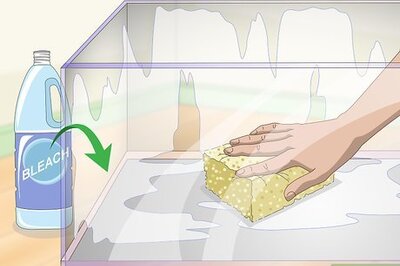
views
“We cannot say that we have studied the islands of Andaman & Nicobar and Lakshadweep.”
This is what Sanjay Kumar, Director, CSDS, said about the two tiny Islands that will be going for the polls in the coming days as part of the 2019 Lok Sabha elections. Such an admission from someone who heads one of the leading survey organisations on Indian electoral politics is a little incredulous but palpably true. The smallest geographies, after all — and contrary to the popular belief — don’t conjure large, often lingering patterns of politics. At least not in the Andaman & Nicobar and Lakshadweep islands.
Sample this: Of all the 340 trips taken by the prime minister Narendra Modi, he has visited Andaman & Nicobar and Lakshadweep only once since he came to power in 2014. This is against an average of 11 visits per state by Modi, according to a News18.com analysis. The data was gathered from the official website of the prime minister’s office that lists his travel itinerary.
The one visit to Andaman & Nicobar was aimed at promoting NITI Aayog’s ‘developmental’ plans for the islands in view of its tourism potential and “strategic advantage”.
And as for precedents concerning visits by past PMs, Manmohan Singh paid two visits to A&N and zero visits to Lakshadweep during 2004-2014.
The electoral irrelevance of the islands of Andaman & Nicobar and Lakshadweep is, perhaps, part of the larger problem of politics and policy being mainland-centric, pushing islands into isolated corners.
So, what are the issues that the islands vote on and, in general, how do the islands vote?
Separating the Bay of Bengal from the Andaman Sea is the archipelago of Andaman and Nicobar (A&N) that comprises about 600 islands and extends over an area of 8,000 sq. kms. Only about 38 of the islands are inhabited and a total of four lakh people reside in these islands.
In contrast, the Lakshadweep islands, located on the other side of the Indian peninsula, covers only an area of about 33 sq. kms and is inhabited by about 65,000 people — 0.4% of the size of A&N with 16% of its population.
Both the islands are Union Territories (UTs) represented at the Centre by one Member of Parliament (MP). In 2014, Bishnu Pada Ray who was elected as MP of A&N in 2009, went on to be reelected, while Lakshadweep saw a change from Congress’ Muhammed Sayeed to NCP’s Mohammed Faizal.
Andaman & Nicobar
From the late 60s to the late 90s, the island’s MPs came from the Indian National Congress (INC) and of these, seven consecutive terms belonged to Manoranjan Bhakta.
Of the entire population of A&N, about 2.7 lakh people were registered voters in 2014 and about 70% of them voted in the general elections to elect one MP — all the islands, taken together, are considered as one constituency.
The structure of governance, though, poses certain challenges.
“MP elections are more about the Centre than the island [A&N],” Zubair Ahmed, a researcher and journalist based in A&N, said. “Almost all decisions are taken by the MHA [Ministry of Home Affairs] and implemented through bureaucratic processes. It’s a problem that we don’t have a legislative assembly here.”
With UTs like Delhi and Pondicherry making repeated demands for statehood for similar reasons and parties like the Nationalist Congress Party (NCP) promising statehood for the islands, we can only assume that problems concerning administrative governance persist across UTs and it would be of interest to note if such issues become part of the campaigning for the 2019 elections.
On March 16, the All India Congress Committee issued a press release with names of selected candidates for the 2019 elections. The list included Kuldeep Rai Sharma, the party’s candidate for Andaman & Nicobar who had also contested as Congress’ candidate in 2009 and 2014 but only managed to come in a close second to Bishnu Pada Ray, the current MP.
The BJP is yet to decide on its candidate for A&N.
The islands also hold a considerable population of aboriginal tribes. The Andamans are home to the Great Andamanese, the Onge, the Jarawas and the Sentinelese and the Nicobar islands are inhabited by the Shompen and Nicobarese tribes. Considered together, Scheduled Tribes (STs) constitute 7.5% of the population as per the 2011 census.
“Out of these tribes, only the Jarawas and the Sentinelese don’t vote,” Ahmed noted.
Talking about the voting patterns of the ones who do vote, he said, “The Nicobarese are a significant vote bank and their votes have largely gone to the Congress.”
Elaborating on the voting patterns of the tribe, Ahmed explained that in 2014, out of about 10,000 votes polled in Car Nicobar, about 9,000 went to the Congress and in Central Nicobar, out of a total of about 5,600 registered votes, about 4,500 went to the Congress. “Even in 2009 and 2004, the Nicobarese voted for the Congress,” he added.
Lakshadweep
Since the past 50-odd years Lakshadweep has held the tag of ‘smallest parliamentary constituency’ in relation to the size of its electorate.
The islands are also noteworthy for their demography. According to the 2011 Census, about 95% of the population comprises of Scheduled Tribes (ST). No wonder then that the only seat is reserved for STs.
The islands also hold a Muslim population that constitutes about 95% of the total population.
Historically, P M Sayeed, who contested as an Independent in 1967 and later aligned with the INC, ruled as an MP for 10 consecutive terms. However, 2004 saw a change when JD(U)’s Pookunhi Koya defeated Sayeed, by a close 71 votes.
In 2009, the island voted for Congress’ Hamdulla Sayeed and in 2014, Hamdulla Sayeed lost to NCP’s Faizal by about 1,500 votes.
Cast Away
Last year, a study by Carnegie India highlighted the “lack of internet access and limited availability of goods and services, infrastructure, and healthcare”, and noted that such factors have “forced the island inhabitants to migrate to mainland India.”
The other problem is that both the UTs are strategically important and viewed largely as “strategic outposts” and this dilutes the focus placed on socio-economic benefits that developmental plans ought to entail.
Both the UTs are also plagued by issues concerning representation.
Speaking about A&N, Ahmed said that locals aren’t included in decision making processes. “Even the various committees that are formed don’t have a significant number of locals as members,” he added.
In response to a question about the kind of benefits that the islands could gain from efforts like the most recent policy plans outlined by NITI Aayog, Ahmed said, “The NITI Aayog plan is for high-end hotels and resorts and does not place any importance on local participation.”
As far as the issues that the islands face, Sanjay Kumar noted: “We have never been to the islands. We can only anticipate that the issues that shape elections in these areas [A&N and Lakshadweep] are very different from those in other parts of India.”


















Comments
0 comment